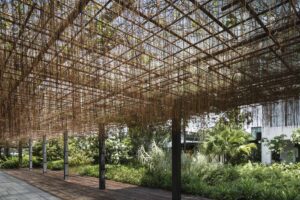
Singapore: Rewilding the garden city
By Gabrielle Stannus
Visiting Singapore recently, I took in a good few of its more manicured horticultural highlights, including the Singapore Botanic Gardens, and its showy counterpart Gardens by the Bay. However, seeking design inspiration of a different type, I trekked out to The Grandstand, a rather ‘unfussy mall’, to visit a landscape architecture studio seeking to rewild not only the gardens, but the hearts and minds of Singaporeans.
You know you have come to an interesting design practice when its principal and founder tells you that it is time for humans to share space with animals. “The garden or the landscape is usually an expression of a part of our relationship with nature. How can people be more interested in nature beyond just the fact that they see it as wellness or healing themselves, but more of the fact that we are after all one being on earth?” asks Chang Huai-Yan, a landscape architect who founded Salad Dressing in 2002.
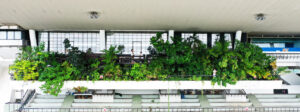
“We are keen to rewild the minds of Singapore, and we are also keen to rewild the ecosystem of the urban ecosystem. It is a challenge to have a very dense population of a certain demography living next to nature,” says Huai-Yan of Singapore’s human population, which as of 2021 stood at 5.897 million with a population density of 8,423.8 people per square kilometre*.
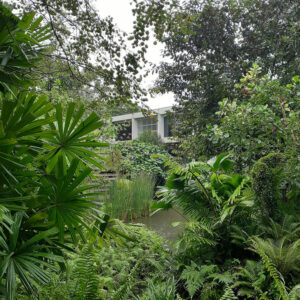
Huai-Yan continues, “I think urban design itself has a certain value at this moment to us, because most of the people who are not really believing so much in nature are (living) in an urban situation. Most of the people who are influencing the rest of the world come from the city, so it (rewilding) must start in a certain way from the urban condition.
“Rewilding has something to do with the heart and the mind. When we talk about rewilding, it is not just action. It is about rewilding people as well, for them to understand so that that goes into a deeper part of engaging. This itself is what we are trying to express.”
As a practice, Huai-Yan explains to me that Salad Dressing is now considering fauna, taxonomical order, and deep time as integral components of their design work. Huai-Yan and his team have started exploring nearby Borneo, part of the ancient Gondwana supercontinent, where dipterocarps have evolved to form the backbone of that island’s tropical rainforests. Seven storeys above the ground, Salad Dressing’s office balcony now holds its own experimental tropical forest containing over containing over 300 species of plants including dipterocarps, breadfruit (Artocarpus altilis), and figs (Ficus spp.) attracting nesting birds, and the occasional hornbill.
“When we look at a tall building or even a house, we start to see how this can become like a holobiont, how all beings made up together to form an ecosystem. And plants are not just there to soften things like a smoking area!” Huai-Yan explains. This approach is evident in Salad Dressing’s greening of the 230-metre-long façade of the Alila Dalit Bay hotel resort near Kota Kinabalu in Borneo. Here, Huai-Yan and his team used the long aerial roots of Ficus spp. to connect the land to the sky, providing a ‘stairway’ for animals seeking fruit, including the civet. This mostly nocturnal mammal is one of the keystone species in the surrounding tropical forest.
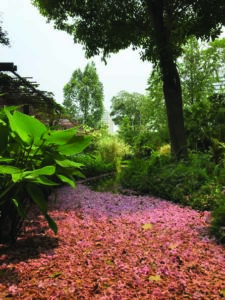
Meena Wong, Senior Landscape Architect and Head Horticulturist with Salad Dressing later showed me how this studio puts its design philosophy into practice in an urban setting. We visited Enabling Village, a community centre for people with disabilities located at Lengkok Bahru, a small ‘heartland’ or neighbourhood in Redhill, beyond Singapore’s city centre. Designed by WOHA Architects and constructed in 2015, this centre is built on the site of the former Bukit Merah Vocational Institute/Employment & Employability Institute.
The site has been opened up to the surrounding neighbourhood, with a variety of spaces and gardens that can be shared by the centre’s users and its neighbours too. A bio pond forms the focal point of the garden and operates without any filter system, with the water cleaned by phytoremediation. Salad Dressing have ‘rewilded’ the soil, increasing microbial activity in the substrate through the incorporation of leaf litter, a technique they have learnt from horticulturists at the Singapore Botanic Gardens.
The lush vegetation that grows as a result attracts local wildlife, including otters, civets, squirrels, birds, and some other less welcome species.
“This red-eared terrapin is released by the public,” says Meena of the presence of this invasive tortoise in the pond, “When the pet terrapin is small, people think it is cute. However, when it grows up, they will release it. Asians tend to think that releasing living things after irresponsible buying is a form of good karma. In the aquatic world, the native fish introduction is part of our intention. So, we have released the apex predator snakehead fish (Channa striata) to compete with the terrapin and African cichlids.”
Fortunately though, Salad Dressing’s carefully selected plant palette is encouraging native fauna to Enabling Village’s gardens. Visiting hornbills enjoy the fruits of Sterculia sp., whilst sunbirds favour the nectar of the Coral Tree’s (Erthyrina sp.) red flowers. The fruit of the Broad Leaf Fig (Ficus auriculata), a cauliflorous species, attracts squirrels, whilst a multitude of palms provide an assortment of fruit to attract animals. Other figs include the Banyan Tree (Ficus bengalensis) and Weeping Fig (Ficus benjamina).
Salad Dressing have provided plenty of plants to suit the interest of humans too, although species have been carefully selected to suit the site’s specific micro-climates. An existing Trumpet Tree (Tabebuia rosea), known as Sakura Tree (Cherry Blossom), features prominently in this garden. “When it drops its pink blossoms during the dry season, this river will be full of pink from the flowers. It is an event or celebration for the people here, for the community,” says Meena. A water-loving Rainbow Eucalypt (Eucalyptus deglupta) inhabits the pond edges, its colourful, peeling bark providing a striking counterpoint to the lush green foliage surrounding it, as does the red papery bark of Syzygium antisepticum.

Perennial herbs abound, with several gingers standing out from the crowd. Red and green-leaved Torch Gingers (Etlingera spp.) provide a link from the understorey to the canopy, whilst potentially contributing to the local ecology. Meena tells me that the ‘human’ locals enjoy consuming its fresh new shoots. When in bloom, the Ginger Lily’s (Hedychium sp.) white flowers release a sweet perfume into the air. Meena shows me what she calls a ‘Bird of Paradise’. Turning my head to look at what I expect to be a Strelitzia sp., I find myself gazing at the bright red bracts of a Heliconia sp., what we refer to in Australia as ‘Lobster Claws’. Common names can confuse across countries; botanical names continue to provide horticulturists across the world with a common language!
Designers know that a garden must look ‘good’ at all times of the day, and from all vantage points. Salad Dressing have allowed climbers to colonise the garden’s vertical surfaces, including built structures and other plants. A Rhaphidophora hayi snakes its way up the trunk of a Tabebuia rosea in its quest for light, whilst the roots of Cissus nodosa (Grape Ivy or Javanese Treebine) dangle from a pergola providing for interesting views from the building’s interior. The needs of those creatures likely to inhabit this space after dark have also been considered, with red and white-flowering night-blooming lilies providing daytime interest to humans, whilst attracting nocturnal pollinators such as moths and bats.
Meena tells me that she returns regularly to Enabling Village, watching its garden evolve over time. “In the beginning, when this garden was formed, there were a lot of flowering plants that we introduced as shrubs. However, once the trees grew, then the sunlight started to disappear. Then those plants started to disappear as well; the shrubs were taken over by the ferns,” says Meena. As the canopy has developed, it has provided more shelter for ferns including Blechnum sp., Nephrolepis sp., and Acrostichum sp. (Mangrove Fern).
Enabling Village has been designed to be inclusive of the physical needs of humans of all abilities. However, one of Salad Dressing’s latest project prioritises access to non-human species for the better part of the year. Meena tells me that this studio is currently working on the redevelopment of the Jurong Lake Gardens, Singapore’s new national garden in the heartlands. This will be this city-state’s third national garden after the Singapore Botanic Gardens and Gardens by the Bay.
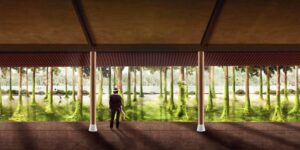
Singapore’s National Parks Board, NParks, describes Jurong Lake Gardens as a people’s garden, where spaces will be landscaped and created for families and the community to come together. Here, concrete canals have already been transformed into naturalised rivers. However, Salad Dressing are taking this rejuvenation one step further with a focus on rewilding. They are creating a riparian forest inside the Jurong Lake Gardens that is designed to withstand monsoonal rains. During drier times, humans will be able to inhabit, and use, this space with ease. However, come the wet season, this forest will be flooded, creating an environment favouring local fauna over Singapore’s human occupants. This riparian forest is yet to be planted, so I may just have an excuse to return to Singapore another time to see whether this landscape has been successfully rewilded!
For more information about Singaporean plants, visit NParks Flora & Fauna Website: https://www.nparks.gov.sg/florafaunaweb.
References
* United Nations (UN) 2021, ‘Singapore: General Information’, UN Data, viewed 10 March 2023, https://data.un.org/en/iso/sg.html
Gabrielle Stannus
Inwardout Studio
M: 0400 431 277
E: gabrielle@inwardoutstudio.com
Main photo: A Grape Ivy’s (Cissus nodosa) roots hang from a pergola at Enabling Village (Image: Salad Dressing)
